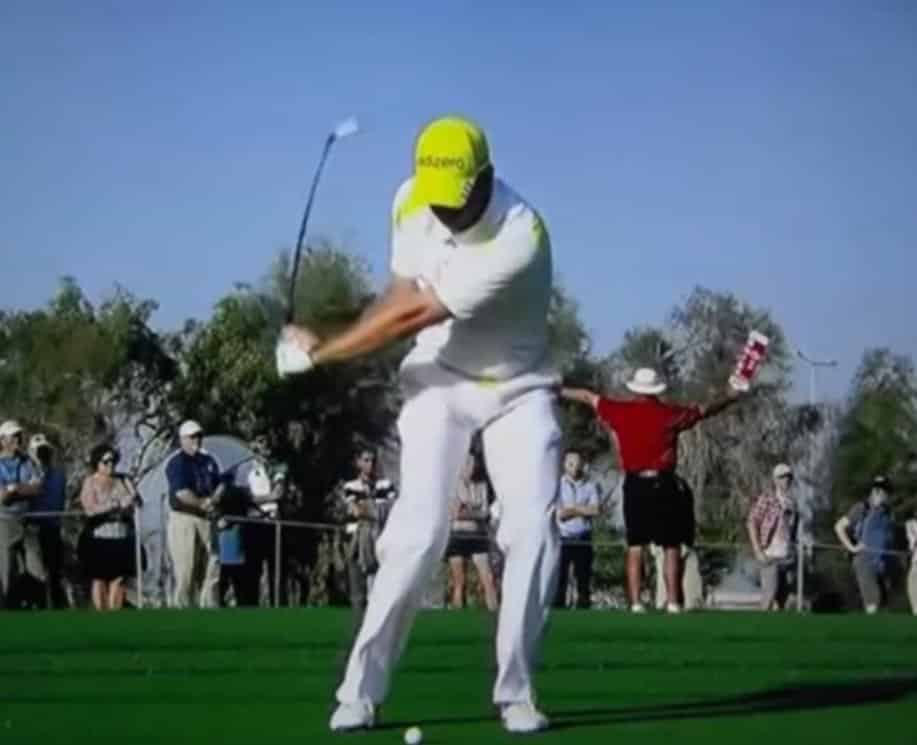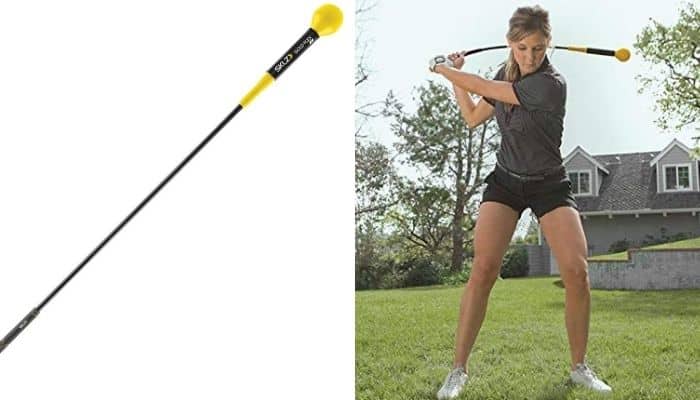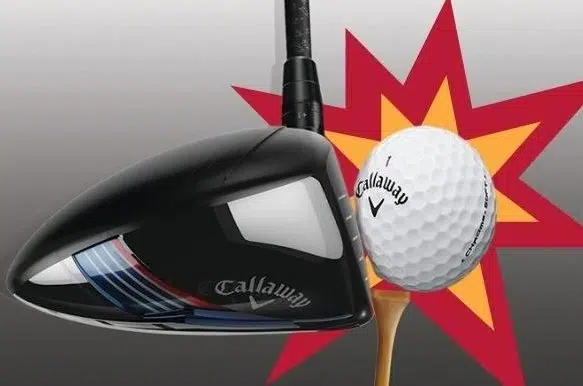Unless you’ve been living under a rock, as a golf fan you would surely know that one thing above just about all else is being obsessed over by many of the pros worldwide: ball speed.
You only need to watch a few of the videos on Bryson DeChambeau’s YouTube channel to get a sense of the time, effort and technology the best players on the planet invest into gaining more distance by increasing their swing speed, and therefore ball speed.
That’s despite someone like DeChambeau already possessing plenty of firepower off the tee.
So, what is the best way to increase ball speed in golf?
To increase ball speed, it is vital to make a full turn of the body, coiling the upper body, hips and legs to generate power. From this position, you should clear your hips, helping the club to lag behind you and then release through impact. Finally, ensure your swing maintains a wide arc, as this will help you increase lag and attack the ball from a shallower, more powerful angle.
In some ways it is a simple equation: swing fast and make efficient contact with the ball, and if the energy imparted on the ball is retained it should come flying off of the clubface as quickly and as far as possible.
You may have heard of this referred to as ‘smash factor’ – a measure of how much clubhead speed is translated to ball speed – with 1.4 generally being a decent target to aim for.
Despite it being pretty clear what creates higher ball speed – swinging fast and translating this swing speed into ball speed – it can be incredibly hard to achieve and replicate time and time again.
There’s quite a bit here to master in order to find that high ball speed which will translate to huge distance, but ultimately, it comes down to creating a powerful swing where the club shallows and you utilise lag to up your pace.
Table of contents
What creates ball speed in golf?
Ball speed is created through an efficient transfer of clubhead speed to the ball, maintaining as much of the momentum and energy created during the swing. This can be summarised by ‘smash factor’ – a measurement of how much clubhead speed is translated into ball speed. A shallow swing which creates lag, along with correct wrist positioning, will help to ensure you create as much ball speed as possible.
There’s essentially two steps to creating high ball speed: generate clubhead speed, then translate it into ball speed through good contact.
One of the best starting points to generate this speed is by creating lag in your swing.
Essentially, lag is created when the clubhead is allowed to ‘lag’ behind the hands and clubhead, bending and stressing the shaft during the downswing.
This creates somewhat of a whipping sensation, accumulating power in the transition into the downswing that is then released through contact with the ball.
Superstar Spaniard Sergio Garcia is one of the PGA Tour’s greatest proponents of lag and cites it as a reason for his success over the years.

What is a good ball speed in golf?
A good ball speed for an average amateur golfer, with driver, is around 140 miles per hour, which will place you above average. The average male golfer achieves a ball speed of around 132 miles per hour, far less than that of the pros who can reach numbers in excess of 170 miles per hour. While ball speed is an important factor to monitor if you want to hit it farther, swing speed and smash factor are equally as important.
In a perfect world, you would achieve a smash factor of about 1.5, but considering Bubba Watson clocks in at 1.52 and Tiger Woods around 1.48, it is pretty unlikely you’re going to hit these numbers.
However, if you do achieve a smash factor of around 1.4 and aren’t satisfied with your ball speed, then increasing your swing speed is probably the place to go.
The 1.4 smash factor indicates a reasonably high level of efficiency, so it’s not that you’re losing that energy when you strike the ball, but more so you haven’t stored up enough energy in the backswing itself.
If you love lashing out on golf gear or are on an obsessive journey to hitting long bombs, getting a hold of a FlightScope Mevo+ will provide all of these numbers including clubhead speed, ball speed and smash factor.
If your smash factor is over 1.4 but you want greater ball speed, turn your attention to increasing the speed of your swing.
How do I increase my golf swing speed?
To increase your swing speed in golf you need to focus on the turning of your hips and legs, using the ground to create and store energy. From the top of the backswing, turn your hips and legs towards your target, pressing into the ground and allowing your upper body to trail behind. Doing this will create lag, with the club shaft bending and stressing behind the body before catching up through impact and releasing this stored power.
It can be a little challenging for amateurs to harness this extra move, but a little bit of a ‘squatting’ action and extra bend through the knees as the hips and legs turn into the downswing can add additional power.
You might often hear pros or high-level golfers talk about the need to use the ground and your legs to generate power in the swing, and what they essentially mean is pressing into the ground a little before exploding upwards when making contact.
Given a lot of amateur players have difficulty with fat and thin shots caused by excessive up and down movement throughout the swing (often caused by early extension), it may be one to avoid if you don’t have good enough hand-eye coordination to match everything up with a deliberate down and up move.
Nonetheless, if you are confident in your abilities or just super desperate to hit it farther it is something that might be worth a try.
When exploring this tip about rotating deep and then firing the hips and legs off early, it’s essentially a means to creating a lagging clubhead.
Lag creates speed in the golf swing due to centrifugal and centripetal forces being imparted on the club.

By keeping the handle of the golf club moving inwards and close to your body, centrifugal forces are placed onto the clubhead, generating stored energy.
When this energy is released in a rapid movement, catching the clubhead back up, it imparts a great deal of energy onto the ball, and – if you are efficient and have a good smash factor – it should lead to a high ball speed.
We explain more about the mechanics of lag in another article here, which I definitely recommend you read.
To work on creating the sensation of lag, I would highly suggest you consider looking at the SKLZ Gold Flex Golf Swing Trainer (pictured above), a training aid designed to get you to feel what a lagging golf swing should be like.
You can’t swing it in a rigid manner due to the bendy shaft and therefore have to wait on the swing at the top, opening your hips and beginning your transition allowing the clubhead to follow afterwards.
It also helps to promote a smoother tempo, training you to swing faster, rather than harder.
Similarly, if you want to actually hit balls on the range while having the same lagging sensation of the SKLZ Flex Golf Swing Trainer, then you may be better off purchasing the Lag Shot Golf Training Aid set.
It comes with a driver, 7-iron and wedge that all have very flexible shafts to help you work on lag, but have proper clubheads that allow you to use them like a normal golf club (something the SKLZ Flex trainer does not).
How do I increase driver speed in golf?
To increase driver speed, try and work on bowing your wrist at the top of the swing which will close the clubface. Doing so allows you to open the hips earlier in order to square the clubface. Making a driver swing like this will help increase lag too, which should translate to higher swing speeds. Given the driver is played from a tee with a positive attack angle, using the ground to squat and explode upwards through contact will also improve driver swing speed.
When working on wrist position, the Total Golf Trainer 3.0 is a product that will help you work towards this bowed wrist action at the top of the swing, maintain correct wrist position to keep the club closed, allowing that big opening and release of the hips to generate speed.
The video below from Athletic Motion Golf sums this concept up perfectly and the need to maintain wrist angle for longer in order to create lag and generate speed.
By reaching maximum hand speed earlier in the swing but keeping the wrists tight, it means the energy and power stored in the club is released later and faster to catch it up to the clubhead, generating both swing speed and ball speed.
Why is my ball speed so slow in golf?
If your ball speed is slow it likely comes down to one of two things: slow clubhead speed or poor retention of energy when you strike the ball. If you swing slow and fail to harness the rotation of your body to create power, you will have less speed, and with it energy, to impart on the ball. Additionally, if you have great club speed but don’t transfer most of it into the ball, then you might see underwhelming ball speed numbers.
The first place to look for increased ball speed is by increasing your swing speed, and one of the biggest methods the pros turn to to achieve this is the SuperSpeed Golf method.
The SuperSpeed Golf Training System is a method to increase swing speed by using differently weighted sticks that many pros and amateurs alike have found to be successful.
Additionally, as discussed above, working on increased lag will also get additional clubhead speed by harnessing a ‘whipping’ motion, as opposed to a stiff, ‘armsy’ motion, to generate more velocity to impart on the ball.
If you have quite a high swing speed but you seem to lose it when transferring it to the ball, you possibly come from over the top and need to work on shallowing out your golf club to strike the ball more from the inside.
By rotating more deeply and shallowing the clubhead you will come more from the inside, and to mitigate this closed clubface you will have to open the hips explosively to square the club.
This combination should create more speed and efficiency of strike.
Does SuperSpeed Golf Training System really work?
Yes, the SuperSpeed Golf training system does work and is used and endorsed by over 600 pros on the PGA and other world tours. The system aims to improve clubhead speed and distance through the science of overspeed training. Through using a combination of training clubs both lighter and heavier than a regular driver, you’ll train your body to increase swing speed by around 5% after six weeks of use.
Essentially, the lighter clubs in the set allow you to swing faster than you usually would with absolute ease, training your body to then swing faster when returning to your regular, heavier club.
In addition to this, the SuperSpeed system encourages people to make both dominant and non-dominant side swings, strengthening both sides of the body to increase stability and, with it, speed.
Final message
Increasing speed can be a slow process and requires practice and training for many people.
However, after a few sessions with a simulator or FlightScope, you should be able to identify whether you lack speed, or just efficiency in converting it to ball speed.
By working on lag and rotation, or using something like the SuperSpeed Training System, you could get some more miles, and with it, yards, in order to impress your buddies and start having more wedges into greens.


